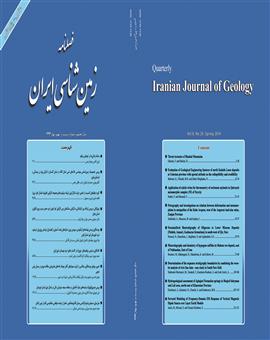مطالعات سنگ¬شناسی، شیمی کانی و سنگ¬زایی باتولیت شیورداغ (شمال اهر- آذربایجان¬شرقی)
محورهای موضوعی :
کلید واژه: پرآلومینوس شوشونیت شیورداغ کلسیمی- قلیایی گرانیتوئید متاآلومینوس.,
چکیده مقاله :
توده گرانیتوئیدی شیورداغ در استان آذربایجانشرقی و شمال اهر، به داخل واحدهای کرتاسه فوقانی تا ائوسن نفوذ کرده و سبب ایجاد دگرگونی مجاورتی و اسکارن زایی شده است. رگه ها و دایک های کوارتز-آپلیتی این توده را قطع می کنند. کانی های اصلی تشکیل دهنده شامل کوارتز، پلاژیوکلاز، پتاسیم فلدسپار، هورنبلند، بیوتیت و کلینو پیروکسن بوده و بافت های پرتیت-آنتی پرتیت، پورفیری، گرانولار و آنتی راپاکیوی بافت های رایج می باشند. براساس مطالعات شیمی کانی، ترکیب بیوتیت ها بین دو قطب استونیت و سیدروفیلیت و آمفیبول های این توده در محدوده منیزیوهاستینگزیت و منیزیوهاستینگزیت هورنبلند قرار می گیرند. کلینوپیروکسنها بیشتر دیوپسیدی بوده و پتاسیم-فلدسپار به قطب سانیدین متمایل بوده و پلاژیوکلازها در محدوده الیگوکلاز تا آندزین قرار می گیرند. دامنه حرارتی تبلور این توده را از ℃ 623 تا ℃750 و فشار جایگیری آن را 5/1 تا 4/2 کیلوبار می باشد. در تقسیم بندی های شیمیایی، این توده در محدوده گرانودیوریت و سینودیوریت قرار گرفته و ویژگی متاآلومینوس نشان می دهد. با افزایش SiO2 مقادیر Al2O3، CaO، MgO و TiO2 سیر نزولی نشان می دهند و در نمودار عنکبوتی، بی هنجاری مشخص و مثبتی برای عناصر Ba ، Rb ، Th ،La ، Ta ، Zr ، Hf ، Cs ، U ، Pb و Pr و نیز ناهنجاری های منفی برای عناصر P ، Nd ، Lu و Mo مشاهده می شود. ماگمای مولد این توده دارای سرشت شوشونیتی و کلسیمی- قلیایی با پتاسیم بالا بوده و در پوسته قاره ای با ضخامت زیاد تا متوسط جایگیری کرده و تحت تاثیر تفریق یا ذوب بخشی و آلایش پوسته ای متحول شده است. این توده در یک محیط ماگمایی پس برخوردی حاشیه فعال قاره ای جایگیری کرده است.
Sheyvardagh granitoeid body is located in north of Ahar, East- Azarbaijan province, intruded into upper Cretaceous up to Eocene units, and caused the contact metamorphism and skarnificaion. This intrusive body in turn cut by veins and Quartz - applite dykes. The major minerals consist of quartz, plagioclase, k-feldspar, hornblende, biotite and clinopyroxene and pertite-antipertite, porphyry, granular and antirapakiwi textures are common in this unit. According to the mineral chemistry studies, the composition of biotite is located between stonite and sydrophilite poles and amphiboles are located in the range of magnesiohestingzite and magnesiohestingzit-hornblend. Clinopyroxenes are diopside and k-feldespar tends to sanidine pole and plagioclase lies in the range of oligoclase to andesine. Thermometry studies indicate the crystallization temperature of this body from 623°C to 750°C and emplacement pressure from 1.5 to 2.4 kb. The rocks are granodioritic and syenodioritic in composition and show has meta-aluminous nature. The producer magma of this body is shoshonitic and calc-alkaline in nature high-k properties. Al2O3, CaO, MgO, and TiO2 indicate descending pattern by increasing of SiO2. In the spider diagrams a distinct and positive anomaly of Ba, Rb, Th, La, Ta, Zr, Hf, Cs, U, Pb and Pr and negative anomalies of P, Nd, Lu and Mo were observed. The producer magma of this body has shoshonitic and high-k calc-alkaline nature and emplaced in a continental crust with high to medium thickness and influenced due to fractional crystallization or partial melting and crustal contamination. This body is emplaced in a post collisional, active continental margin setting.

